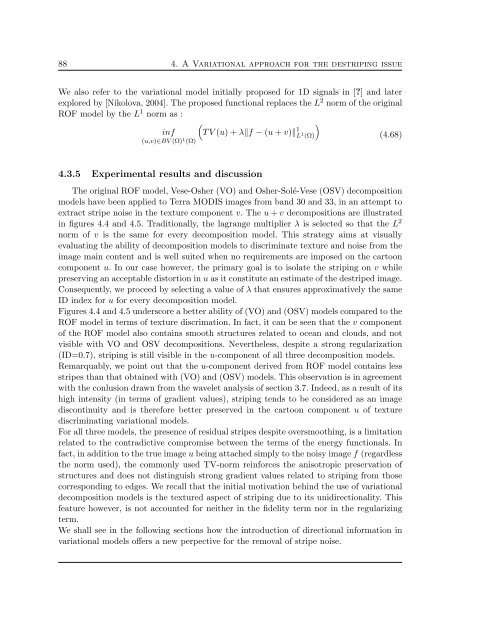Th`ese Marouan BOUALI - Sites personnels de TELECOM ParisTech
Th`ese Marouan BOUALI - Sites personnels de TELECOM ParisTech
Th`ese Marouan BOUALI - Sites personnels de TELECOM ParisTech
Create successful ePaper yourself
Turn your PDF publications into a flip-book with our unique Google optimized e-Paper software.
88 4. A Variational approach for the <strong>de</strong>striping issue<br />
We also refer to the variational mo<strong>de</strong>l initially proposed for 1D signals in [] and later<br />
explored by [Nikolova, 2004]. The proposed functional replaces the L 2 norm of the original<br />
ROF mo<strong>de</strong>l by the L 1 norm as :<br />
inf<br />
(u,v)∈BV (Ω) 1 (Ω)<br />
(<br />
)<br />
TV(u)+λ‖f − (u + v)‖ 1 L 1 (Ω)<br />
(4.68)<br />
4.3.5 Experimental results and discussion<br />
The original ROF mo<strong>de</strong>l, Vese-Osher (VO) and Osher-Solé-Vese (OSV) <strong>de</strong>composition<br />
mo<strong>de</strong>ls have been applied to Terra MODIS images from band 30 and 33, in an attempt to<br />
extract stripe noise in the texture component v. The u + v <strong>de</strong>compositions are illustrated<br />
in figures 4.4 and 4.5. Traditionally, the lagrange multiplier λ is selected so that the L 2<br />
norm of v is the same for every <strong>de</strong>composition mo<strong>de</strong>l. This strategy aims at visually<br />
evaluating the ability of <strong>de</strong>composition mo<strong>de</strong>ls to discriminate texture and noise from the<br />
image main content and is well suited when no requirements are imposed on the cartoon<br />
component u. In our case however, the primary goal is to isolate the striping on v while<br />
preserving an acceptable distortion in u as it constitute an estimate of the <strong>de</strong>striped image.<br />
Consequently, we proceed by selecting a value of λ that ensures approximatively the same<br />
ID in<strong>de</strong>x for u for every <strong>de</strong>composition mo<strong>de</strong>l.<br />
Figures 4.4 and 4.5 un<strong>de</strong>rscore a better ability of (VO) and (OSV) mo<strong>de</strong>ls compared to the<br />
ROF mo<strong>de</strong>l in terms of texture discrimation. In fact, it can be seen that the v component<br />
of the ROF mo<strong>de</strong>l also contains smooth structures related to ocean and clouds, and not<br />
visible with VO and OSV <strong>de</strong>compositions. Nevertheless, <strong>de</strong>spite a strong regularization<br />
(ID=0.7), striping is still visible in the u-component of all three <strong>de</strong>composition mo<strong>de</strong>ls.<br />
Remarquably, we point out that the u-component <strong>de</strong>rived from ROF mo<strong>de</strong>l contains less<br />
stripes than that obtained with (VO) and (OSV) mo<strong>de</strong>ls. This observation is in agreement<br />
with the conlusion drawn from the wavelet analysis of section 3.7. In<strong>de</strong>ed, as a result of its<br />
high intensity (in terms of gradient values), striping tends to be consi<strong>de</strong>red as an image<br />
discontinuity and is therefore better preserved in the cartoon component u of texture<br />
discriminating variational mo<strong>de</strong>ls.<br />
For all three mo<strong>de</strong>ls, the presence of residual stripes <strong>de</strong>spite oversmoothing, is a limitation<br />
related to the contradictive compromise between the terms of the energy functionals. In<br />
fact, in addition to the true image u being attached simply to the noisy image f (regardless<br />
the norm used), the commonly used TV-norm reinforces the anisotropic preservation of<br />
structures and does not distinguish strong gradient values related to striping from those<br />
corresponding to edges. We recall that the initial motivation behind the use of variational<br />
<strong>de</strong>composition mo<strong>de</strong>ls is the textured aspect of striping due to its unidirectionality. This<br />
feature however, is not accounted for neither in the fi<strong>de</strong>lity term nor in the regularizing<br />
term.<br />
We shall see in the following sections how the introduction of directional information in<br />
variational mo<strong>de</strong>ls offers a new perpective for the removal of stripe noise.















